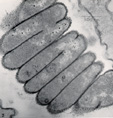 |
BIOL
230 MICROBIOLOGY LECTURE E-TEXT UNIT 4 |
MICROBIOLOGY LEARNING OBJECTS
UNIT 4
 |
BIOL
230 MICROBIOLOGY LECTURE E-TEXT UNIT 4 |
MICROBIOLOGY LEARNING OBJECTS
UNIT 4
II. THE EUKARYOTIC CELL
III. FUNGI
IV. PROTOZOA
V. VIRUSES
TABLE OF CONTENTS
TOPICS
I. The Eukaryotic Cell
a. The Nucleus
4. Other Internal Membrane-Bound Organelles
a. Mitochondria
b. Chloroplasts
5. Ribosomes
II. Fungi
Back to Doc Kaiser's Microbiology Website.
Gary E. Kaiser, Ph.D.
Professor of Microbiology
The Community College of Baltimore County, Catonsville Campus
This work is licensed under a Creative Commons Attribution 4.0 International License.
Based on a work The Grapes of Staph at https://cwoer.ccbcmd.edu/science/microbiology/index_gos.html.Last updated: August, 2021
Please send comments and inquiries to Dr. Gary Kaiser